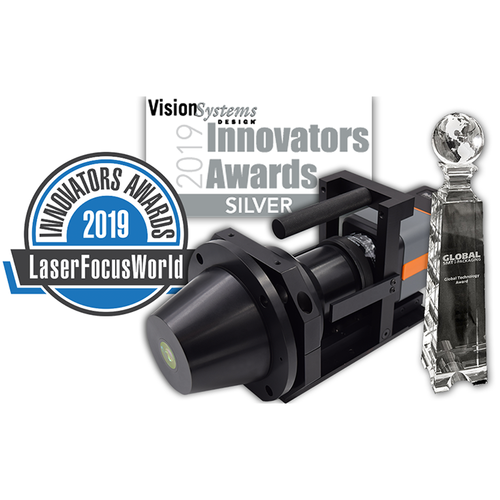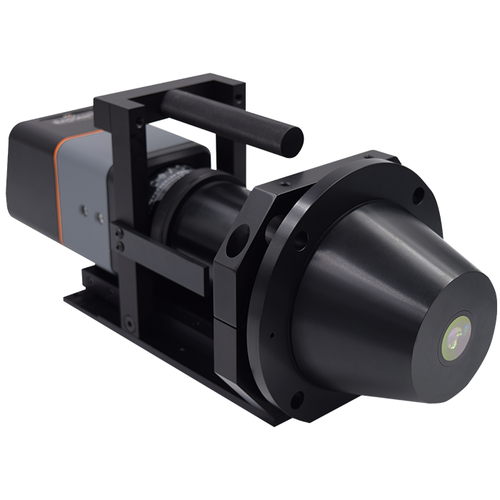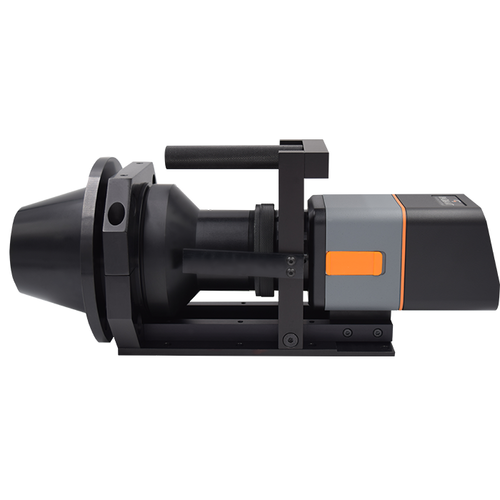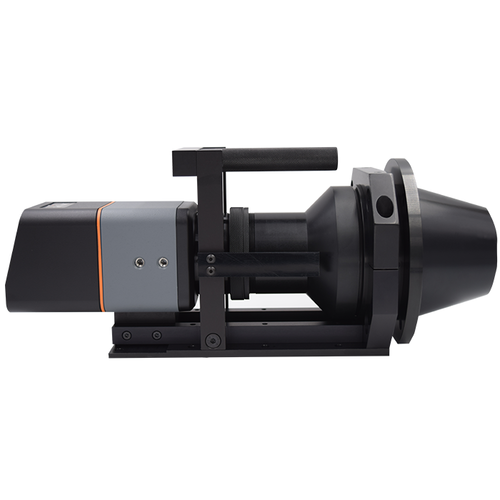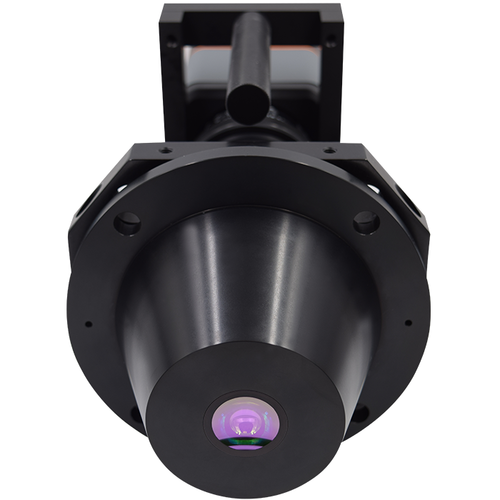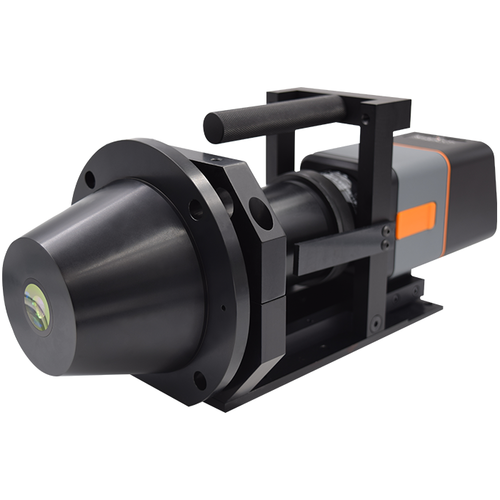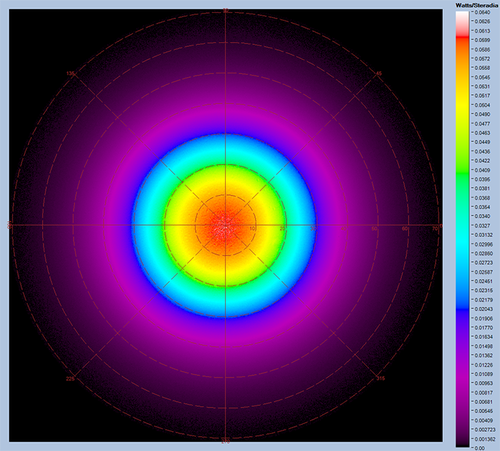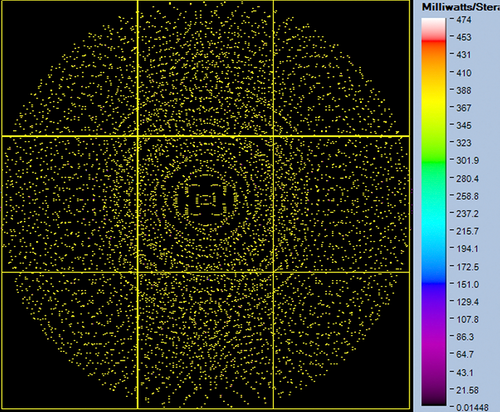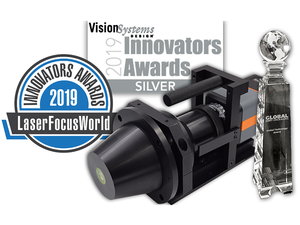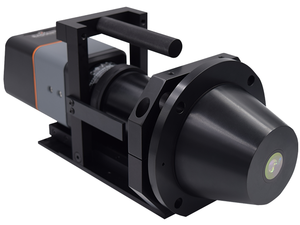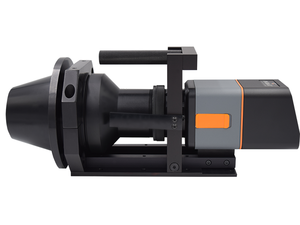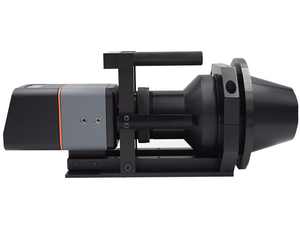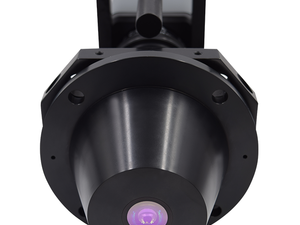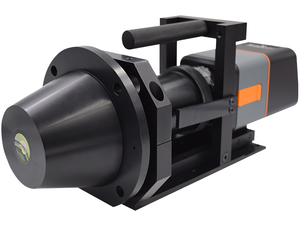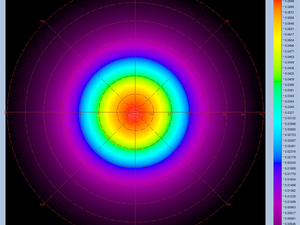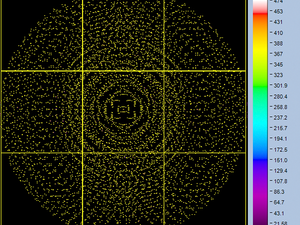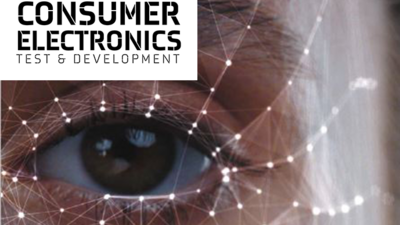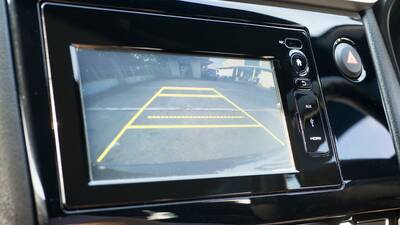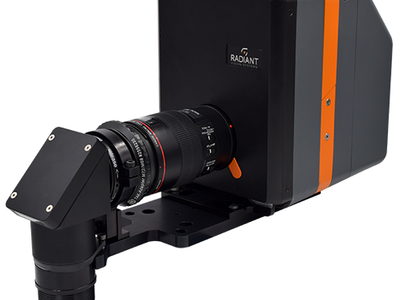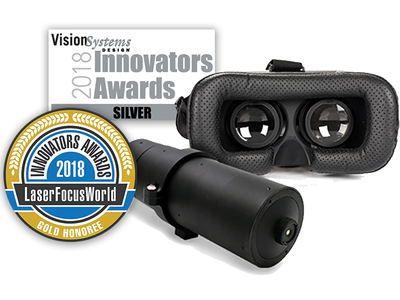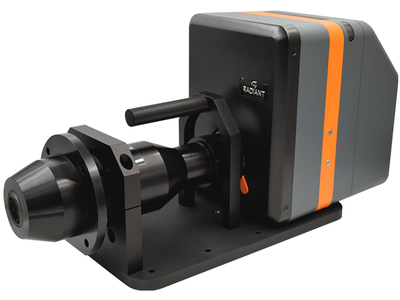NIR Intensity Lens
Fast, accurate radiant intensity measurement solution for evaluation of near-infrared light sources and distributions.
Near Infrared 3D Sensing
Three-dimensional sensing technology is the foundation of multiple new applications, such as:
- Facial and gesture recognition
- Eye tracking and iris detection
- Lidar for autonomous vehicles, drones, robotics
- Simultaneous localization and mapping (SLAM)
- Other near-infrared 3D sensing applications
Measurement techniques for NIR LEDs and lasers ensure the performance of Time-of-Flight (ToF) light-based proximity sensing and 3D sensing using dot patterns produced by diffractive optical elements (DOE). To ensure performance and accuracy of devices and systems that use NIR sensing, an effective test and measurement solution is needed.
Near-Infrared Intensity Lens Solution
The Radiant Vision Systems Near-Infrared (NIR) Intensity Lens system is an integrated camera/lens solution that measures the angular distribution and radiant intensity of 850 or 940 nm* near-infrared (NIR or near-IR) emitters. The NIR Intensity Lens system utilizes Fourier optics to capture a full cone of data in a single measurement to ±70 degrees, giving you extremely fast, accurate results ideal for in-line quality control.
Manufacturers of 3D sensing technology can apply the NIR Intensity Lens solution for angular measurement of NIR LEDs, lasers, and structured light patterns produced by Diffractive Optical Elements (DOE). The lens mounts directly to a Radiant Vision Systems ProMetric® Imaging Radiometer, and features ProMetric or TrueTest™ Software for intuitive system setup and customizable automated measurement sequences. Additional tests specific to NIR emission measurement are available.
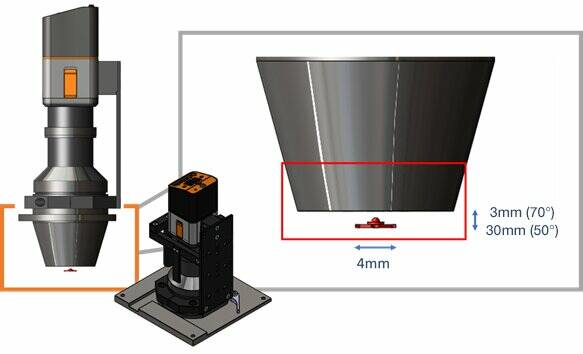
Example of NIR Intensity Lens positioned above an NIR-emitting light source to analyze the complete angular distribution.
High-Resolution Angular Measurement
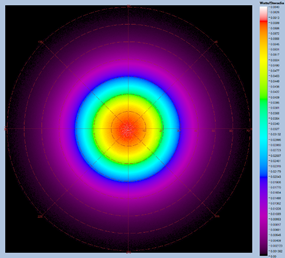
The NIR Intensity Lens captures the complete angular distribution of an NIR light source (to ±70 degrees) in a single image, and achieves an angular resolution of up to approximately 0.05 degrees per image sensor pixel. Paired with the ProMetric® Imaging Radiometer, the NIR Intensity Lens has the capability to measure radiant intensity, power, and radiant flux with a high degree of accuracy at each view angle. This ensures both accurate distribution and intensity of NIR emissions for object sensing, and safe levels of NIR output for use in human-machine interface applications such as eye and facial sensing.
Safety Considerations
The human eye does not respond to invisible wavelengths of NIR light the same way it does to bright visible light, and therefore can be damaged by NIR emissions. For example:
- IEC 62471 standard for all light sources, required in America, Asia, and Europe
- IEC 60825-1 standard for lasers, including any NIR lasers
- American Conference of Governmental Industrial Hygienists (ACGIH) Threshold Limit Values (TLVs) for Physical Agents (including “lasers, light and near-infrared radiation”)
Radiant’s near-IR measurement solutions characterize the output of NIR sources, providing manufacturers with data that may be useful when testing to these standards.
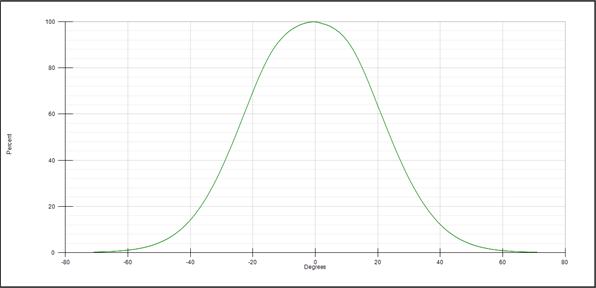
Cross-section radar plot showing radiant intensity (as a function of angle) of a near-infrared LED, captured by the NIR Intensity Lens and output by TrueTest Software.
Structured Light Dot Pattern Analysis
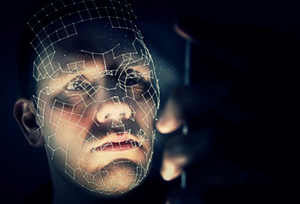
Diffractive optical elements (DOE) distribute NIR laser emissions in a structured light pattern (often tens of thousands of dots) over a wide spatial area. This pattern is produced when a single beam of NIR laser light is emitted through a DOE “screen”, which splits it into multiple emission points, typically creating thousands of dots. This pattern is cast on the 3D surface of a target object, such as a face. As the laser light interacts with the object, each of the dots in the array is reflected back to the device’s NIR sensor at a different angular location, size, and intensity, indicating depth and curvature. Calculating the deviation of distributed light versus received reflected light, the sensing device can construct a 3D “map” of the object.
Each dot in a structured light pattern must be accurately positioned (correct angle, inclination, azimuth) to ensure it is properly reflected back and “understood” by the emitting device’s infrared sensor. Manufacturers need to control the position and output of each dot for the device to correctly map the contours of the target object. It is also important to control the radiant intensity (W/sr) intensity of each point to ensure correct levels of NIR output in applications—such as facial recognition and iris tracking—where the human eye is exposed to NIR emissions.
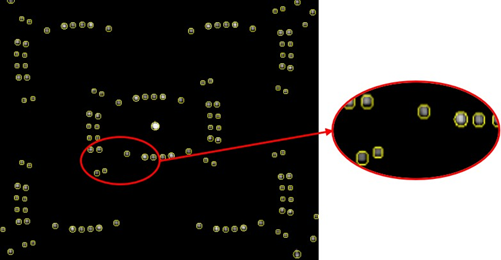
Dot emissions created using a diffractive optical element (DOE) are captured by the Radiant NIR Intensity Lens solution and analyzed for angular location, maximum radiant intensity, uniformity, and flux.
Radiant’s NIR Intensity Lens can identify points of interest across the image, measuring point-by-point values for maximum peak (strongest emitter), location at x,y, maximum peak inclination/azimuth, maximum peak averages, maximum peak solid angle, number of pixels as maximum peak point, spot power uniformity (between dots), total flux, and DOE flux (subtracting the background peak).
"Flood" Source Analysis
Object sensing may rely on a strong flash of NIR light (sometimes referred to as “flood” distribution) for proximity detection through time-of-flight (ToF) measurement. For example, in facial recognition flood emitters can be used to detect the presence of a face and determine focus distance, even in darkness. The NIR Intensity Lens provides Flood Source Analysis to evaluate diffuse NIR sources to ensure they adhere to intended performance parameters, and to identify and correct any irregularities such as hot spots or intensity fall-off.
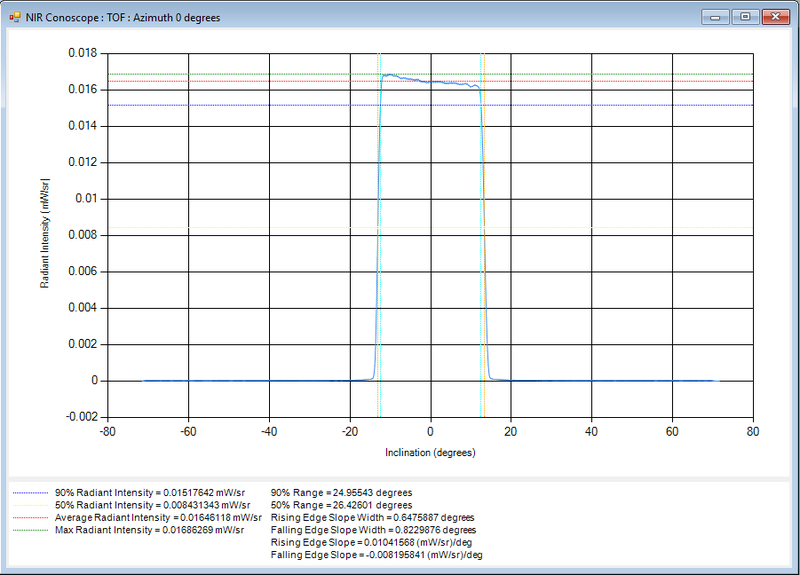
Analyze flood distribution of diffuse NIR light sources to evaluate uniformity across angular emissions (in terms of intensity at each degree), center values, angular fall-off, or hot-spots.
Complete Measurement Solution
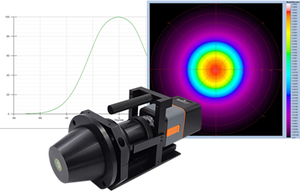
The NIR Intensity Lens provides an application-specific solution for complete NIR source characterization and emission measurement. Paired and calibrated with a ProMetric Y Imaging Radiometer, the NIR Intensity Lens provides a turnkey radiometric imaging solution that meets the form factor, measurement efficiency, and cost requirements for multiple applications.
The Radiant NIR solution software provides tests specific to the evaluation of angular distributions of NIR light, as well as dot patterns produced by DOE. You can sequence tests for rapid evaluation of all relevant display characteristics in a matter of seconds, applying selected tests to a single image captured by the camera. Unique tests for NIR analysis include:
|
|
Radiant solutions are combined hardware/software systems configured for exact application needs, which enable manufacturers to achieve more efficient measurement processes using a single provider with end-to-end support.
NIR Intensity Lens Key Features and Highlights:
- Accurate and reliable measurement of radiant intensity up to ±70° angle.
- High angular resolution (up to approximately 0.05 degrees per image sensor pixel).
- Efficient operation, capturing data for all angles simultaneously. Faster than goniometric systems for analyzing angular data.
- Compact form factor.
- Combination of low cost, high performance, and flexibility.
- Easy-to-use measurement control and analysis software.
Awards and Recognition:
The NIR Intensity Lens has been honored with these awards for innovation:
- Vision Systems Design – 2019 Innovators Awards; Silver-level
- GLOBAL SMT & Packaging – 2019 GLOBAL Technology Awards; “Metrology” category
- Laser Focus World – 2019 Innovators Awards; Gold-level
| Parameter | NIR Intensity Lens (Camera and Lens Solution) | |
|---|---|---|
| Primary application | Near-IR radiant intensity distribution measurement | |
| Integrated camera | ProMetric® Imaging Radiometer | |
| Working distance | 30 mm | 3 mm |
| Sampling size | Up to 4 mm diameter | |
| Field of view | ± 50° | ± 70° |
| Approx. Resolution | 0.03° / sensor pixel | 0.05° / sensor pixel |
| Wavelength | 850 nm, 940 nm* | |
| Measurement capabilities | Radiant Intensity, Power, Radiant Flux | |
| Units | W/sr, W | |
| Additional analysis features | Export to text file, cross-sections, points of interest, radar plots | |
*For applications at wavelengths outside of 850 nm or 940 nm, please speak to a Radiant sales representative.
Specifications are subject to change without notice.
System Recommendations:
- TT-NIRI™ Software
- Windows® 10, 64 bit
- 16-32 GB RAM
Typical Applications
The NIR Intensity Lens provides an efficient measurement solution for near-infrared (NIR) sources such as LEDs and lasers. This camera/lens solution offers high-resolution imaging to address both off-line and in-line applications:
- Angular measurement for devices used for 3D sensing applications including facial recognition, gesture recognition, eye tracking, multimodal human machine interface (HMI), and automotive LiDAR.
- Evaluation of 850 or 940 nm* light sources for accurate radiant intensity output at all angles.
- Measurement of NIR LEDs, lasers, and structured light patterns produced by diffractive optical elements (DOE).
- Fast operation for in-line measurement for quality control during production.
* For applications at wavelengths outside of 850 nm or 940 nm, please speak to a Radiant sales representative.

